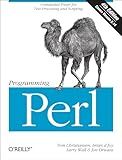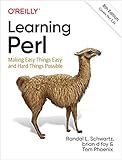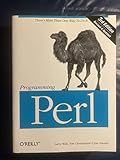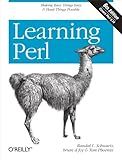Best Perl Programming Guides to Buy in December 2025

Programming Perl: Unmatched power for text processing and scripting
- AFFORDABLE PRICING FOR QUALITY USED BOOKS IN GOOD CONDITION.
- THOROUGHLY INSPECTED TO ENSURE MINIMAL WEAR AND TEAR.
- ECO-FRIENDLY CHOICE, PROMOTING SUSTAINABILITY THROUGH REUSE.



Learning Perl: Making Easy Things Easy and Hard Things Possible



CGI Programming with Perl: Creating Dynamic Web Pages
- AFFORDABLE PRICES FOR QUALITY USED BOOKS, SAVING YOU MONEY!
- ECO-FRIENDLY CHOICE: SUPPORT RECYCLING AND REDUCE WASTE.
- SUPPORTS READERS: UNIQUE FINDS THAT ENRICH YOUR COLLECTION.



Programming Perl (3rd Edition)
- QUALITY ASSURANCE: ALL BOOKS ARE INSPECTED FOR GOOD CONDITION.
- ECO-FRIENDLY CHOICE: SUPPORT SUSTAINABILITY BY BUYING USED BOOKS!
- AFFORDABLE PRICES: SAVE MONEY WITHOUT SACRIFICING QUALITY READING.



Higher-Order Perl: Transforming Programs with Programs



Perl Pocket Reference: Programming Tools
- AFFORDABLE PRICES: ENJOY SAVINGS ON QUALITY READS.
- QUALITY ASSURANCE: CAREFULLY INSPECTED FOR GOOD CONDITION.
- ECO-FRIENDLY CHOICE: PROMOTE SUSTAINABILITY BY BUYING USED.



Learning Perl
- AFFORDABLE PRICES FOR QUALITY BOOKS YOU CAN TRUST!
- ECO-FRIENDLY CHOICE: GIVE BOOKS A SECOND LIFE!
- WIDE SELECTION ACROSS GENRES FOR EVERY READER'S TASTE!



Regular Expression Pocket Reference: Regular Expressions for Perl, Ruby, PHP, Python, C, Java and .NET (Pocket Reference (O'Reilly))


To download files over HTTPS with Perl, you can use the following steps:
- First, you need to install the required Perl modules. The most commonly used module for making HTTPS requests in Perl is LWP::UserAgent. You can install it using the cpan command: cpan LWP::UserAgent
- Once the module is installed, you can begin writing your Perl script. Start by including the necessary libraries: use LWP::UserAgent; use File::Basename;
- Create an instance of the LWP::UserAgent class: my $ua = LWP::UserAgent->new;
- To enable SSL/TLS, you need to set the HTTPS scheme handler: $ua->ssl_opts(verify_hostname => 1);
- Specify the URL of the file you want to download: my $url = 'https://example.com/file-to-download.zip';
- Extract the filename from the URL using the basename function from the File::Basename module: my $filename = fileparse($url);
- Create a GET request and capture the response: my $response = $ua->get($url);
- Check if the request was successful: if ($response->is_success) { # File contents are available in $response->content # Save the file to a desired location open(my $file, '>', $filename) or die "Could not open file: $!"; print $file $response->content; close($file); print "Download complete.\n"; } else { die "Download failed: ", $response->status_line; }
- Run the Perl script. It will make an HTTPS request, download the file, and save it to the specified location.
Note: Remember to handle any potential errors, such as network issues or server unavailability, to ensure the script's robustness.
How to authenticate with a username and password while downloading files over HTTPS in Perl?
To authenticate with a username and password while downloading files over HTTPS in Perl, you can use the LWP::UserAgent module along with a credentials method. Here's an example:
use LWP::UserAgent;
URL of the file to download
my $url = 'https://example.com/file-to-download.txt';
Username and password for authentication
my $username = 'your-username'; my $password = 'your-password';
Create a user agent object
my $ua = LWP::UserAgent->new;
Set the credentials for the URL
$ua->credentials($url, '', $username, $password);
Make the HTTP GET request and save the file
my $response = $ua->get($url);
Check if the request was successful
if ($response->is_success) { # Save the file to disk open(my $file, '>', 'downloaded-file.txt'); print $file $response->content; close($file); print "File downloaded successfully.\n"; } else { print "Failed to download file: " . $response->status_line . "\n"; }
In this example, you need to replace the $url, $username, and $password variables with your specific details. The credentials method sets the username and password for the specified URL. The get method of the LWP::UserAgent object sends an HTTP GET request, and the response object contains the downloaded file content.
What is the default timeout value for downloading files over HTTPS in Perl?
The default timeout value for downloading files over HTTPS in Perl is typically set to 180 seconds (3 minutes). However, this value can be customized by the developer using the appropriate modules or libraries, such as LWP::UserAgent, to handle the HTTPS requests.
How to handle server-side file restrictions while downloading over HTTPS in Perl?
To handle server-side file restrictions while downloading over HTTPS in Perl, you can use the LWP::UserAgent module, which allows you to make HTTPS requests and handle server responses.
Here is an example code that demonstrates how to handle server-side file restrictions:
use LWP::UserAgent;
my $url = 'https://example.com/file.pdf'; my $ua = LWP::UserAgent->new;
Set the user agent string
$ua->agent('Mozilla/5.0 (Windows NT 10.0; Win64; x64) AppleWebKit/537.36 (KHTML, like Gecko) Chrome/89.0.4389.82 Safari/537.36');
Set the maximum size limit of the response
$ua->max_size(1024 * 1024); # 1MB
Make the HTTP GET request
my $response = $ua->get($url);
if ($response->is_success) { # File downloaded successfully my $content = $response->content; # Perform operations on the downloaded file content as needed # ... } else { # Handle error cases if ($response->code == 403) { # Access to the file is forbidden (server-side restriction) print "Access to the file is forbidden.\n"; } else { # Other errors print "Error downloading file: " . $response->status_line . "\n"; } }
In this example, the LWP::UserAgent module is used to send a GET request to the specified URL. If the request is successful ($response->is_success), you can access the downloaded file content from the response object's content method.
If the server responds with a 403 Forbidden status code, it means that access to the file is restricted. You can check for this specific status code and handle it accordingly.
Note that this example code does not handle SSL/TLS certificate verification. If you need to handle self-signed certificates or other certificate-related issues, you may need to use additional modules or configurations.
What is the difference between HTTP and HTTPS when it comes to downloading files?
The main difference between HTTP (Hypertext Transfer Protocol) and HTTPS (Hypertext Transfer Protocol Secure) when it comes to downloading files is the security aspect.
- Encryption: HTTPS ensures that the data exchanged between the web server and the client (user's device) is encrypted, making it difficult for unauthorized parties to intercept and understand the content being downloaded. This encryption is usually implemented using SSL/TLS protocols.
- Security: HTTP does not provide any significant security measures, making it susceptible to various attacks like man-in-the-middle attacks or eavesdropping. On the other hand, HTTPS is designed to provide a secure connection, preventing unauthorized access or tampering of data during transmission.
- Trust and Authentication: HTTPS employs digital certificates issued by trusted Certificate Authorities (CAs) to verify the identity of the website server. This ensures that users are connecting to the intended server and not to a malicious or impersonated one. In contrast, there is no verification or validation in HTTP.
- Port: HTTP operates over port 80, while HTTPS operates over port 443. Some networks may restrict or monitor traffic on specific ports, so the use of HTTPS may enable downloading files in scenarios where HTTP is blocked or limited.
In summary, HTTPS adds an extra layer of security to prevent data interception, ensure authenticity of servers, and protect against potential threats during file downloads compared to HTTP.
How to handle server errors during the file download process over HTTPS in Perl?
To handle server errors during the file download process over HTTPS in Perl, you can use the LWP::UserAgent module which provides convenient methods for making HTTP requests.
Here's an example code snippet:
use LWP::UserAgent; use HTTP::Request;
Create a user agent object
my $ua = LWP::UserAgent->new;
Specify the URL of the file to be downloaded
my $url = 'https://example.com/file.txt';
Create an HTTP GET request
my $request = HTTP::Request->new(GET => $url);
Send the request and get the response
my $response = $ua->request($request);
Check if the request was successful
if ($response->is_success) { # If successful, save the downloaded file my $content = $response->content; open(my $fh, '>', 'downloaded_file.txt') or die "Can't open file for writing: $!"; print $fh $content; close($fh); } else { # If not successful, handle the server error my $status = $response->status_line; die "Error downloading file: $status"; }
In the above code, the LWP::UserAgent module is used to create a user agent object which is responsible for making the HTTP request. The HTTP::Request module is used to create an HTTP GET request with the specified URL.
The request is sent using the request method of the user agent object, and the response is obtained. If the response is successful (HTTP status code in the range of 200-299), the downloaded file content is saved to a file named downloaded_file.txt. Otherwise, if the response indicates a server error, an error message is displayed.
Make sure you have the necessary modules installed before running the code. You can install them using CPAN or a package manager like cpanm.
